Wow thats all very interesting I think I'd like to find out about those crystals too I have a rose soap I made, one of my first soaps ( I just started making soap not to long ago) so it has glycerin rivers in it but it smells so perfect like the real thing I'd like to perfect my recipe as a keeper. And I know how to get rid of glycerin rivers now so I will attempt this recipe again after Christmas.I like to scent my soaps sorta like a thai cook flavors their food, by balancing salty, sour, sweet, spicy and creamy, except for scent rather than flavor.
Spicy, sour, woodsy, medicinal is more expensive base & middle notes, 70%, which always need sweet from cheaper top note. For my pt ls I hope to accentuate the woodsy scent of the pt w/ the base note cedarwood, and then add some sweet top note w/ the grapefruit. EOs are the only preservative i ever use.
Yesterday I was reverse engineering some of Dr Bronner's liquid soaps esp for scent- Dr B's Peppermint uses peppermint EO plus 'Mentha Arvensis', a USP food-grade peppermint crystal available for sale on Amazon that sounds really amazing. Dr B makes me feel so inadequate.
Anybody smelled Br B's ls rose scent? Is that stuff amazing, or what?
I emailed Dr B to ask if this was fragrance oil bc I was well aware rose otto costs $100 tsp n figured maybe he was using concrete, but Dr Bronner replied back to me:
"The natural rose fragrance is made up of a blend of essential oils, like Geranium, Davana, Eucalyptus, rose otto and Orange, plus components of other essential oils that have been fractionated. There is a minimal amount of rose essential oil in our rose fragrance, since rose essential oil costs about $5000 a pound. However, everything is natural and has not been adulterated or synthesized in any way
Please rest assured that we do not use fragrances or perfumes in our products."
I think it's absolutely amazing how Dr B blended those EOs together to make such a perfect copy of a true rose scent.
My soap would smell so dope if I mixed some peppermint EO in w/ this methol crystals like Dr B uses: https://a.co/d/e5ujzeB
<-----(amazon link to Mentha Arvensis USP food grade crystals, anybody used this stuff?)
DrB's lavender liquid soap uses lavender and lavendin EXTRACT (NOT essential oils). Lavender and lavendin extract (organic) are also found on Amazon. I am not aware if any of my normal suppliers sell these menthol crystals or lavender/lavendin extracts.
I ran my ls recipe thru SoapCalc and noticed I scored a 0/24 in cleansing w/ my 100% olive ls recipe I've been using in the bathtub for years, but when I add 30% coconut my 'cleansing' score went way up, at which point I noticed my recipe needs castor for ricinoleic, sunflower for linolenic, flaxseed oil for linolenic whenever I'm not soapin' w/ lots of olive, and i might consider seeking out more cost-efficient non-hydrogenated sources for stearic besides the raw, organic cocoa butter i love dearly. Sigh.
My very simple liquid soaps have been standing me in very good stead for many years now, but thru SoapCalc i see they could be better; however; SoapCalc's 0% score on cleansing for my 100% olive oil soap is not right.
100% olive ls is a very powerful but gentle cleanser that's perfect for hair / skin.
I love olive oil.
Another thing I noticed- you know how everybody always says not to go above 30% coconut on any soap recipe? Dr B is a $350mn/year S-Corp who uses coconut as his #1 ingredient for both bar and liquid soap- this coconut value for both liquid and bar soap is almost certainly above 30%...
Anybody else use palm kernel oil in their liquid soap, like Dr B?
I don't understand why Dr B uses palm kernel oil in liquid soap.
Isn't palm kernel oil primarily used for making bar soap harder?
You are using an out of date browser. It may not display this or other websites correctly.
You should upgrade or use an alternative browser.
You should upgrade or use an alternative browser.
how to factor in pine tar?
- Thread starter Zing
- Start date

Help Support Soapmaking Forum:
This site may earn a commission from merchant affiliate
links, including eBay, Amazon, and others.
You are misunderstanding what "cleansing" means on the calculator. It really refers to how much oil will be stripped off your skin. All soap will get you clean, even at 0 cleansing value, which includes 100% lard and 100% OO bar soap.My very simple liquid soaps have been standing me in very good stead for many years now, but thru SoapCalc i see they could be better; however; SoapCalc's 0% score on cleansing for my 100% olive oil soap is not right.
100% olive ls is a very powerful but gentle cleanser that's perfect for hair / skin.
It is ridiculous that all soap calculators suggest an ideal cleansing range of 12 to 22. This causes many new soapers to strive for a mid-range around 17. That's way too high for so many people, especially those with eczema or psoriasis. Many hand-crafted soapmakers strive for a cleansing value under 12 for all their soaps.
This is another area where the original soap calculators did not do a good job, but it has never been changed because people are used to it the way it is. The ideal cleansing range really ought to be 0-20 in my opinion, or perhaps 5-20 at the most. I tried to suggest this when they were making updates to SoapmakingFriend, but it fell on deaf ears. Hopefully someone, someday, will fix this.
It's just like the default lye setting of 38% water as percent of oils - there's another old benchmark that ought to be scrapped, or at least, not be the default setting as opposed to lye concentration.
Also, do be aware that many oils behave a little differently in LS than they do in bar soaps, so the values you see in the calculator may not hold true for your LS anyway.
Last edited:
So if most of my soaps have a cleansing rate of 20 to 22 how do I bring it downYou are misunderstanding what "cleansing" means on the calculator. It really refers to how much oil will be stripped off your skin. All soap will get you clean, even at 0 cleansing value, which includes 100% lard and 100% OO bar soap.
It is ridiculous that all soap calculators suggest an ideal cleansing range of 12 to 22. This causes many new soapers to strive for a mid-range around 17. That's way too high for so many people, especially those with eczema or psoriasis. Many hand-crafted soapmakers strive for a cleansing value under 12 for all their soaps.
This is another area where the original soap calculators did not do a good job, but it has never been changed because people are used to it the way it is. The ideal cleansing range really ought to be 0-20 in my opinion, or perhaps 5-20 at the most. I tried to suggest this when they were making updates to SoapmakingFriend, but it fell on deaf ears. Hopefully someone, someday, will fix this.
It's just like the default lye setting of 38% water as percent of oils - there's another old benchmark that ought to be scrapped, or at least, not be the default setting as opposed to lye concentration.
Also, do be aware that many oils behave a little differently in LS than they do in bar soaps, so the values you see in the calculator may not hold true for your LS anyway.
Less CO and/or PKO.So if most of my soaps have a cleansing rate of 20 to 22 how do I bring it down
Would I bring up my OO as I bring down the CO would that work? I use CO,PO,and OOLess CO and/or PKO.
@CLMP I assume you mean for your pine tar recipe? I ask because we are in the pine tar thread. 
To offset the softness of the pine tar, I use a lots of tallow, low water, and no soft oils:
55% tallow
20% CO
20% PT
5% castor
2% SF, 45% lye concentration
PS: I melt and blend all the oils together, including the pine tar, then add the lye solution. Recommend hand stirring only. It takes a little longer to reach trace but it stays pourable.
To offset the softness of the pine tar, I use a lots of tallow, low water, and no soft oils:
55% tallow
20% CO
20% PT
5% castor
2% SF, 45% lye concentration
PS: I melt and blend all the oils together, including the pine tar, then add the lye solution. Recommend hand stirring only. It takes a little longer to reach trace but it stays pourable.

$12.94 ($0.92 / Fl Oz)
Nutiva Organic Coconut Oil with Butter Flavor from non-GMO, Steam Refined, Sustainably Farmed Coconuts, 14-ounce
HAVE A GREAT DAY!

$8.62
$14.99
The Natural Soap Making Book for Beginners: Do-It-Yourself Soaps Using All-Natural Herbs, Spices, and Essential Oils
Amazon.com

$29.99 ($0.37 / Ounce)
$35.95 ($0.45 / Ounce)
Skin Said Yes 5Lb Goats Milk Soap Base - SLS/SLES free, No Palm Oil, Organic Soap Base, Bulk Goat Milk Melt and Pour Soap Base, Natural Soap Base for Soap Making Organic, Soap Making Supplies
Smart Brands Lab USA

$35.74 ($0.32 / Ounce)
Nature's Oil Coconut 76 Degree, Naturally Refined, 7lbs (1 Gallon)
Bulk Apothecary

$7.64 ($0.48 / Fl Oz)
$8.99 ($0.56 / Fl Oz)
Viva Naturals Refined Coconut Oil - Expeller-Pressed Organic Coconut Oil for Cooking and Baking with Neutral Flavor & Aroma - USDA Organic Certified Hair Oil and Skin Moisturizer, 16 Fl Oz
Amazon.com

$23.05 ($0.36 / Ounce)
$24.99 ($0.39 / Ounce)
Golden Barrel Butter Flavored Coconut Oil (32 oz.) 2 Pack
JF Distributions

$11.99 ($3.00 / Fl Oz)
Ethereal Nature 100% Pure! Peppermint Oil – Perfect For Aromatherapy Diffusers, Skin, Nail and Hair Care – Beauty DIY – 4 FL OZ
Amazon.com

$25.28 ($0.32 / Ounce)
$32.00 ($0.40 / Ounce)
Primal Elements Triple Butter Soap Base (Mango, Shea, and Cocoa Butter) - Moisturizing Melt and Pour Glycerin Soap Base for Crafting and Soap Making, Vegan, Cruelty Free, Easy to Cut - 5 Pound
Amazon.com

$13.01 ($0.41 / Ounce)
$17.00 ($0.53 / Ounce)
Primal Elements Clear Soap Base - Moisturizing Melt and Pour Glycerin Soap Base for Crafting and Soap Making, Vegan, Cruelty Free, Easy to Cut, Unscented - 2 Pound
Amazon.com

$16.95 ($4.24 / Fl Oz)
Pure Body Naturals French Lavender Essential Oil Blend, 4 fl oz - for Aromatherapy, Soap Making, and DIY Skin and Hair Products
Pure Body Naturals®
Opps sorry I forgot we were talking about PT. those oils I mentioned I use for my other main recipe I do. I just started thinking alot about the cleansing rate in my soaps and kinda went off topic. I just checked and my cleansing rate for my PT is 17 so I should try to bring it down. I use only OO and CO with a little Caster oil. I might try tallow in the future.@CLMP I assume you mean for your pine tar recipe? I ask because we are in the pine tar thread.
To offset the softness of the pine tar, I use a lots of tallow, low water, and no soft oils:
55% tallow
20% CO
20% PT
5% castor
2% SF, 45% lye concentration
PS: I melt and blend all the oils together, including the pine tar, then add the lye solution. Recommend hand stirring only. It takes a little longer to reach trace but it stays pourable.
Also I put my pine tar through gel faze will it still gel faze at 45% lye concentration I haven't gone that steep yet lol sorry I always have so many questions.@CLMP I assume you mean for your pine tar recipe? I ask because we are in the pine tar thread.
To offset the softness of the pine tar, I use a lots of tallow, low water, and no soft oils:
55% tallow
20% CO
20% PT
5% castor
2% SF, 45% lye concentration
PS: I melt and blend all the oils together, including the pine tar, then add the lye solution. Recommend hand stirring only. It takes a little longer to reach trace but it stays pourable.
- Joined
- Dec 8, 2017
- Messages
- 136
- Reaction score
- 148
thanks for pointing those particularities regarding the lye calc, AliYou are misunderstanding what "cleansing" means on the calculator. It really refers to how much oil will be stripped off your skin. All soap will get you clean, even at 0 cleansing value, which includes 100% lard and 100% OO bar soap.
It is ridiculous that all soap calculators suggest an ideal cleansing range of 12 to 22. This causes many new soapers to strive for a mid-range around 17. That's way too high for so many people, especially those with eczema or psoriasis. Many hand-crafted soapmakers strive for a cleansing value under 12 for all their soaps.
This is another area where the original soap calculators did not do a good job, but it has never been changed because people are used to it the way it is. The ideal cleansing range really ought to be 0-20 in my opinion, or perhaps 5-20 at the most. I tried to suggest this when they were making updates to SoapmakingFriend, but it fell on deaf ears. Hopefully someone, someday, will fix this.
It's just like the default lye setting of 38% water as percent of oils - there's another old benchmark that ought to be scrapped, or at least, not be the default setting as opposed to lye concentration.
Also, do be aware that many oils behave a little differently in LS than they do in bar soaps, so the values you see in the calculator may not hold true for your LS anyway.
So, a 10% pt ls w/ 60:30 olive : coconut gives me a Cleansing score of 20 on SoapCalc, which I'll adjust based on your input to 70:20 for a cleansing score of 13.
The reason I used 10% pt, instead of 5% or 15%, is because oldwhippersnappers.com discloses on his website they use 6.5% pine tar. See below.
I like this ingredient list much more than the one below from Granpas that's full of preservatives w/ an ingredient list similar to Pantene. I'd buy this soap:
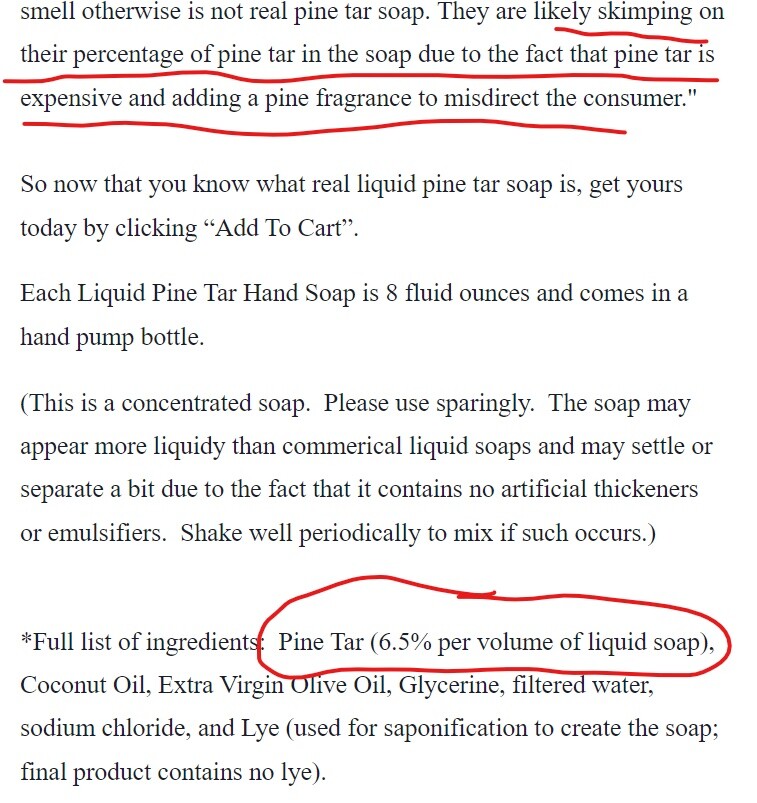
Here is an example of some pt soap I wouldn't buy, but I do like how he's using cedarwood, tea tree, & peppermint to scent his pt soap. I have all those EOs on-hand so i think i'll use that. That accord sounds lovely. Nevermind about the grapefruit, the BB 1st distill peppermint eo will sweeten it up nicely. LOVE bb 1st distill peppermint...
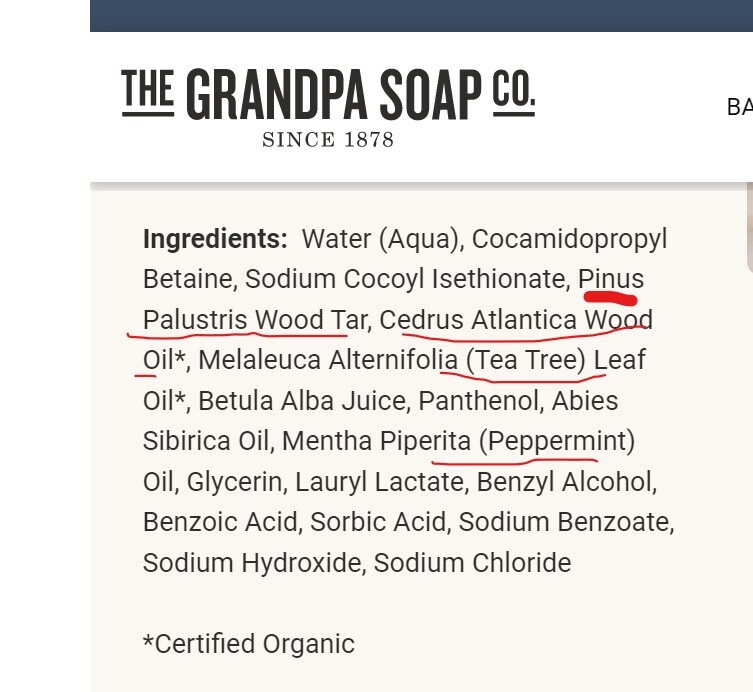
How does Granpa get away with marketing his soaps as moisturizing? Does that mean he's good w/ having his soap regulated as a cosmetic? He's also inferring that after the irritated skin is moisturized it won't be irritated anymore and that's walking the tight rope w fda...
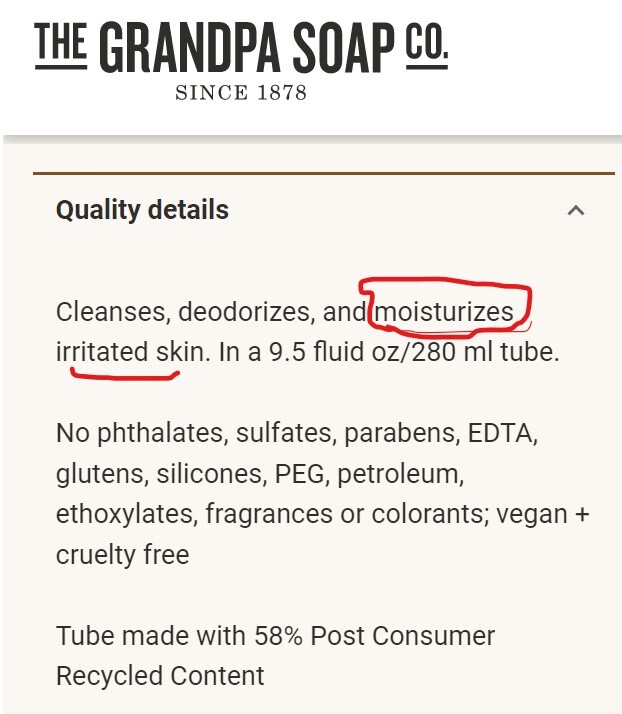
Last edited:
@johnnyusa His label says that the 6.5% pine tar is based on the finished (diluted) soap - not the mix of oils that he used to make the paste. If that is correct and not a typo, and if we assume he diluted his paste at 50%, then there would be 13% pine tar in the paste recipe. If he diluted at 75%, then he'd have 19.5% pine tar.
Even so, I would agree it is misleading to list pine tar first, since typically the ingredient list would start with the ingredient of highest percentage, and go in order down to the lowest.
The second recipe isn't a true "soap" at all. With all the syndets and no saponifiable oils in there, the sodium hydroxide would be used as a pH modifier only. Funny how folks will gladly use a body wash like that, which actually contains sodium hydroxide, but be worried about using bar soaps (where all the NaOH is gone after production).
Even so, I would agree it is misleading to list pine tar first, since typically the ingredient list would start with the ingredient of highest percentage, and go in order down to the lowest.
The second recipe isn't a true "soap" at all. With all the syndets and no saponifiable oils in there, the sodium hydroxide would be used as a pH modifier only. Funny how folks will gladly use a body wash like that, which actually contains sodium hydroxide, but be worried about using bar soaps (where all the NaOH is gone after production).
- Joined
- Dec 8, 2017
- Messages
- 136
- Reaction score
- 148
All done w/ 10% pt ls olive:coconut 70:20
here's what it looks like initially right after mixing the lye w the fats and stickblending until i got some solids
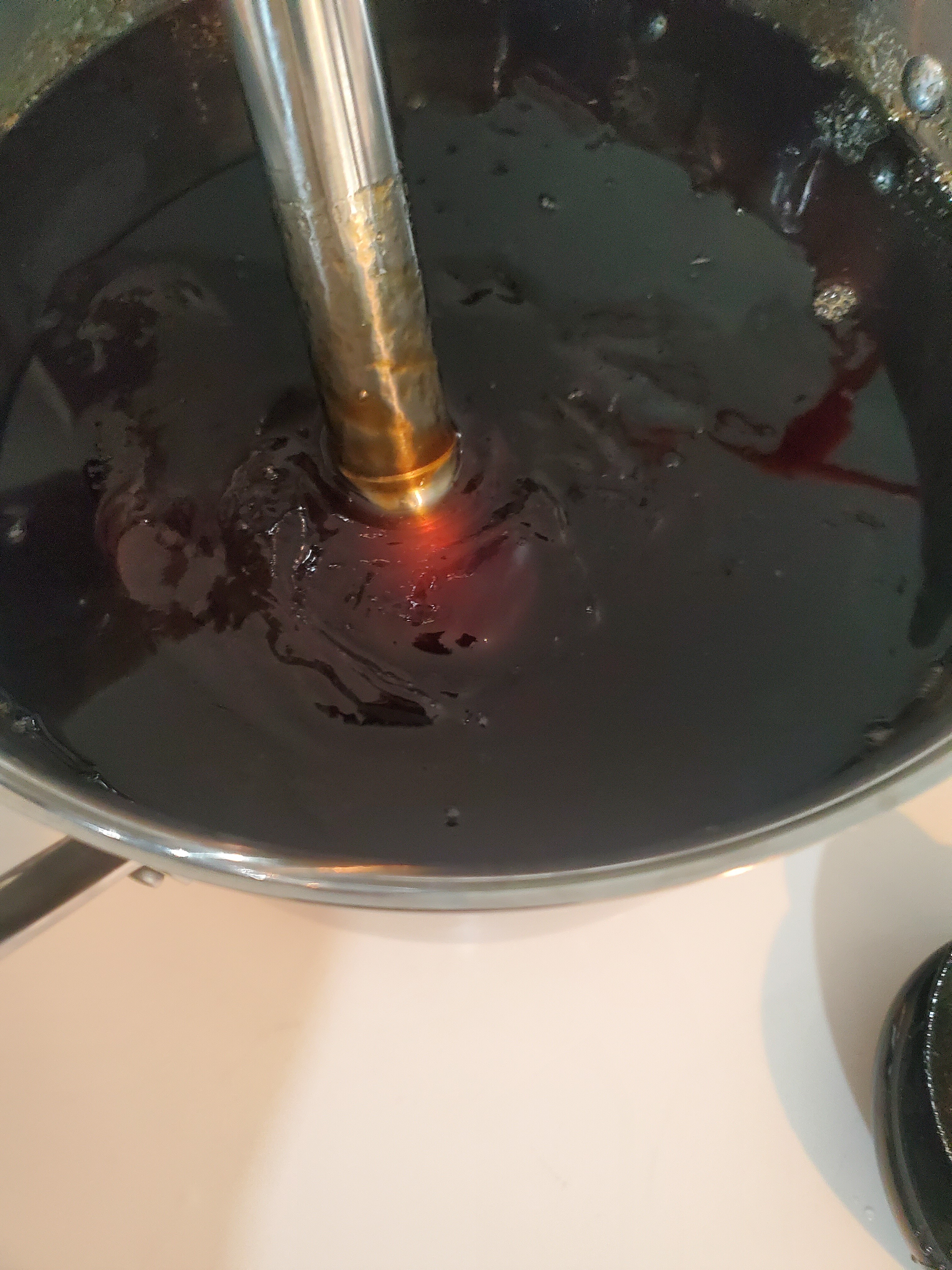
i started off by melting the tar in a water bath for better pourability and easier measuring
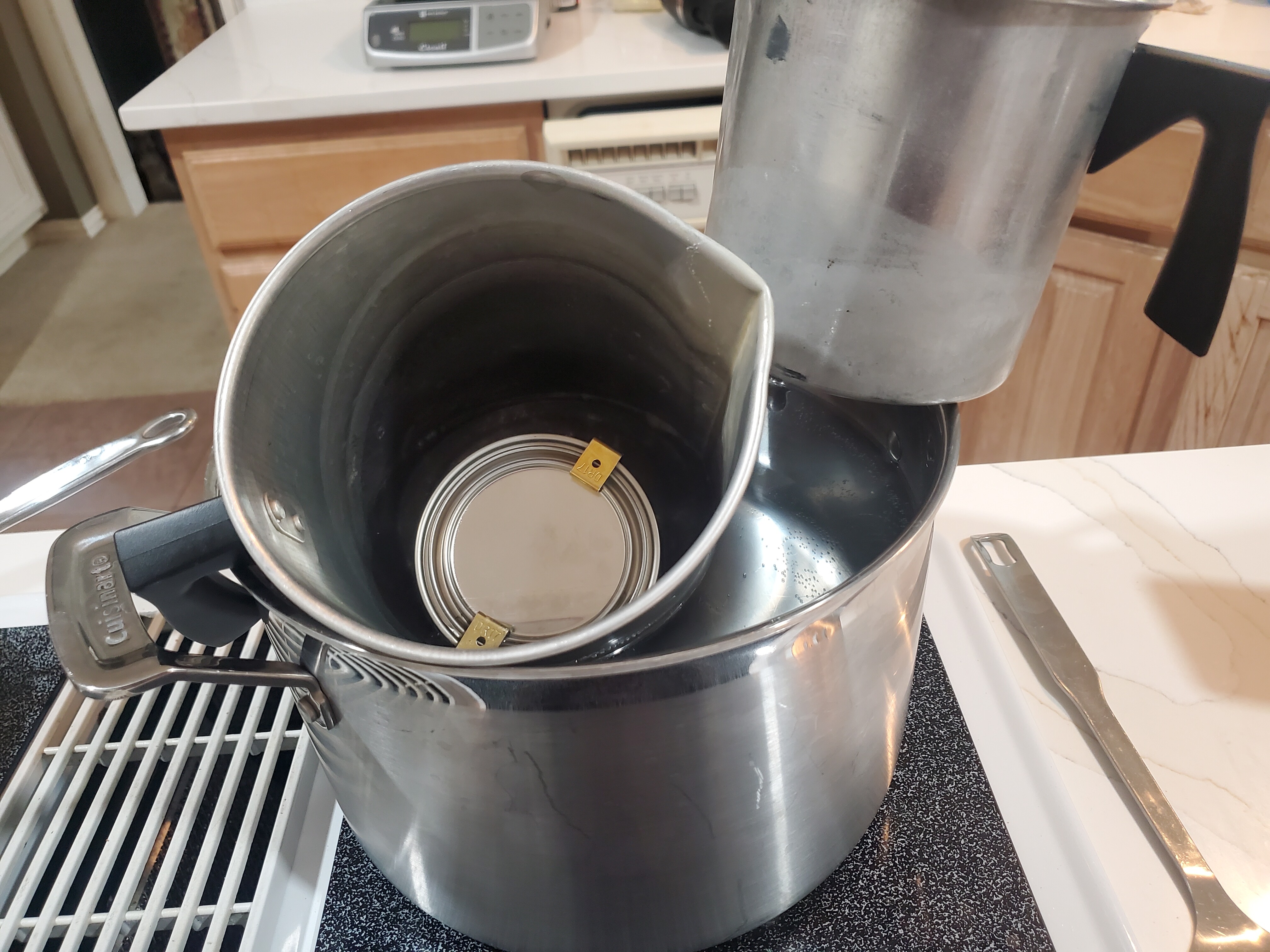
then i measured & poured 10oz pine tar into smaller melting bowl to keep it soft while i melt the coconut, & measure the olive, lye, & glycerin
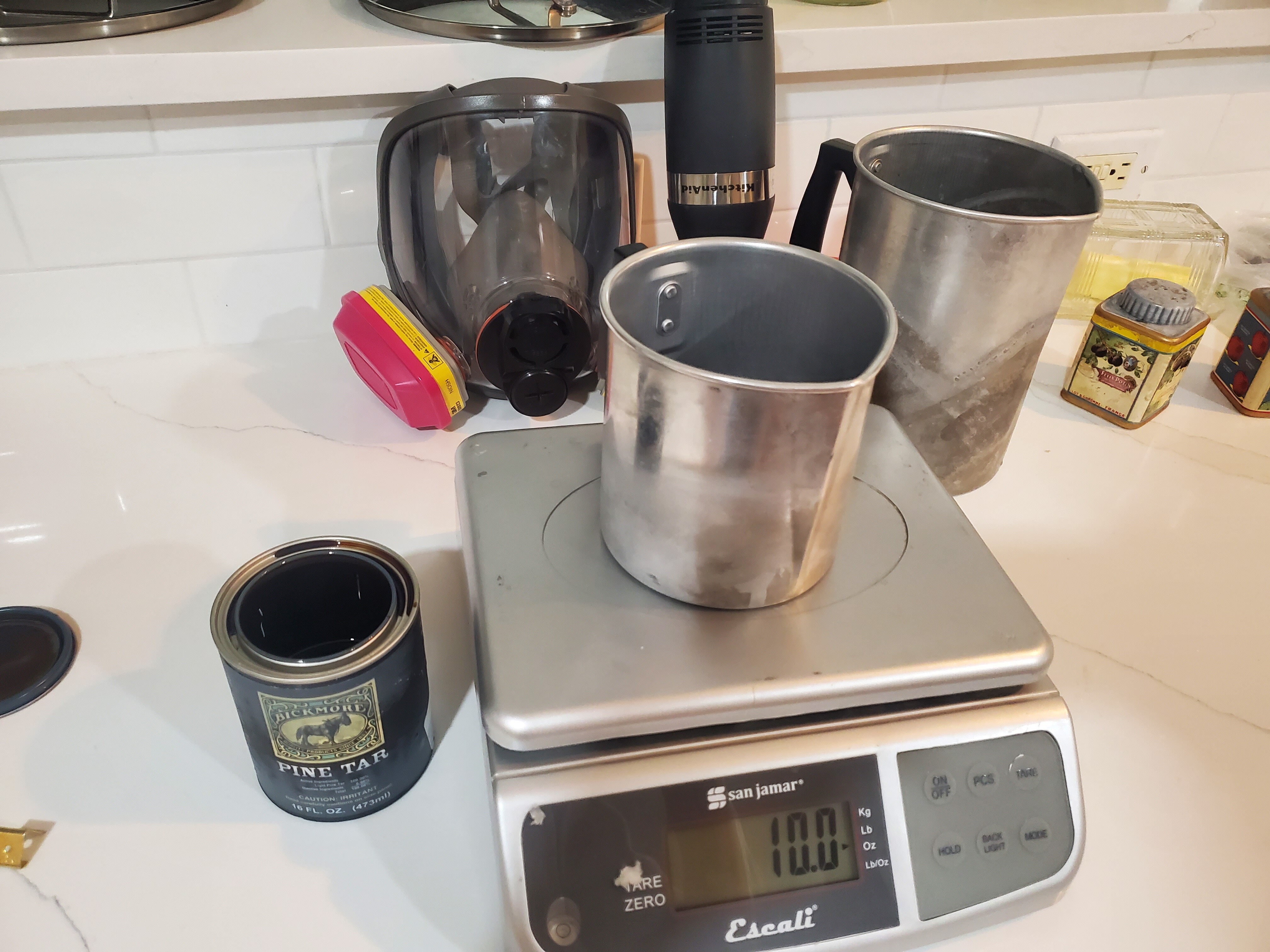
putting 20oz coconut in the main pot to melt
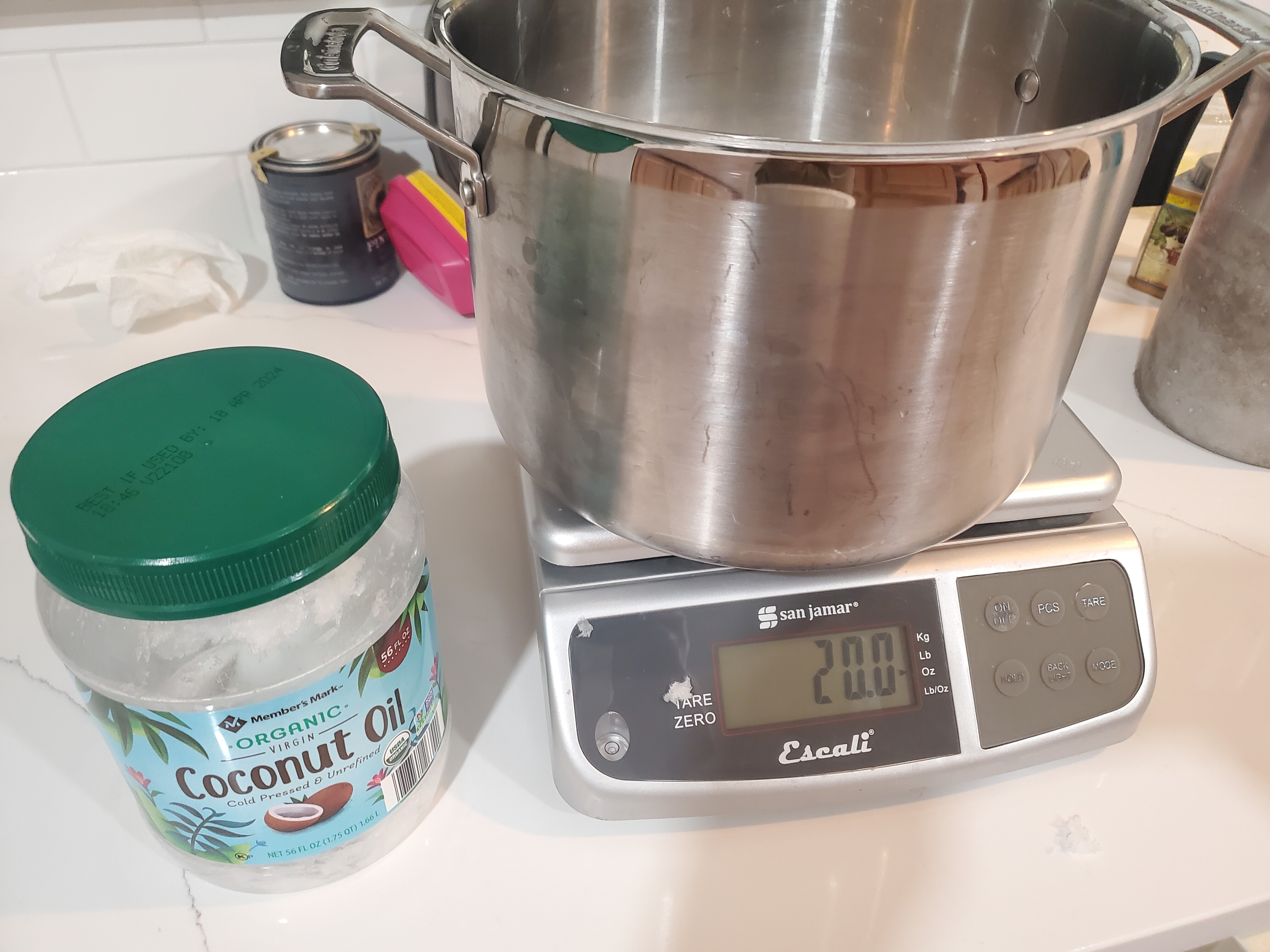
measuring the lye
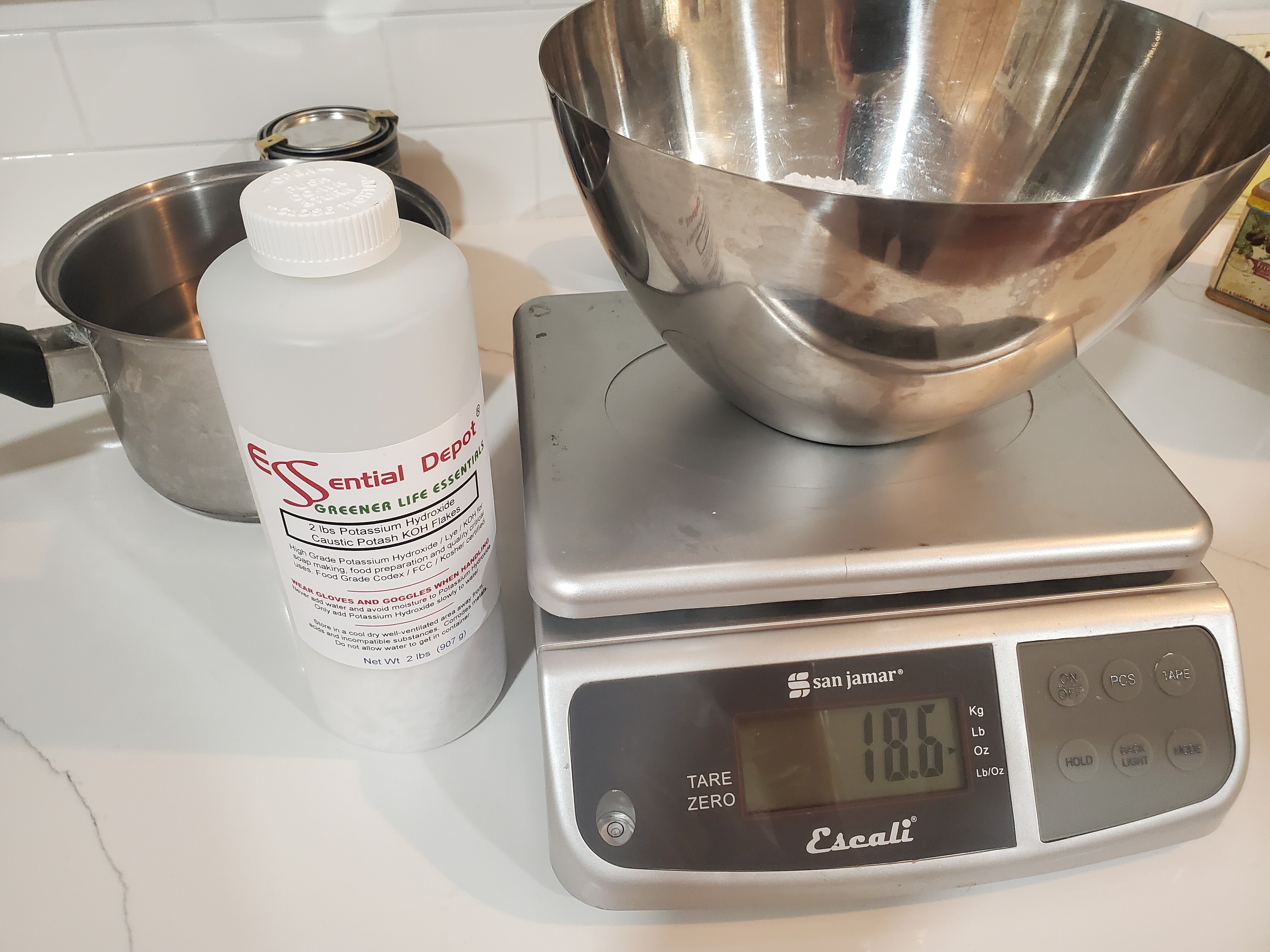
actually i measured the glycerin first and accidentally used the lye value of 18.4 when it was supposed to be 61 so when I realized what i did i subtracted 18.4 from 61 and added that much more glycerin to make it right
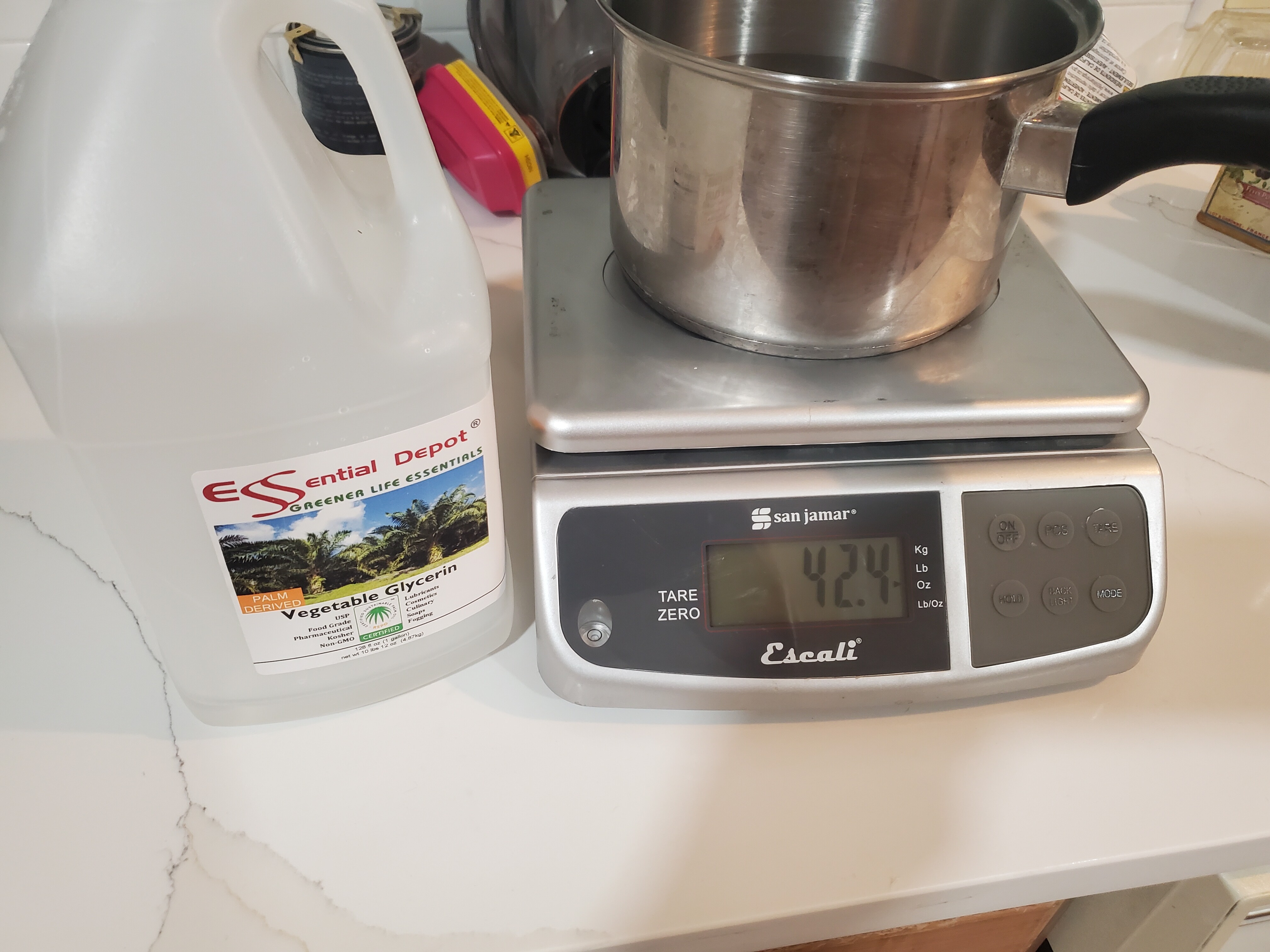
the lye mixed into glycerin pre-blend
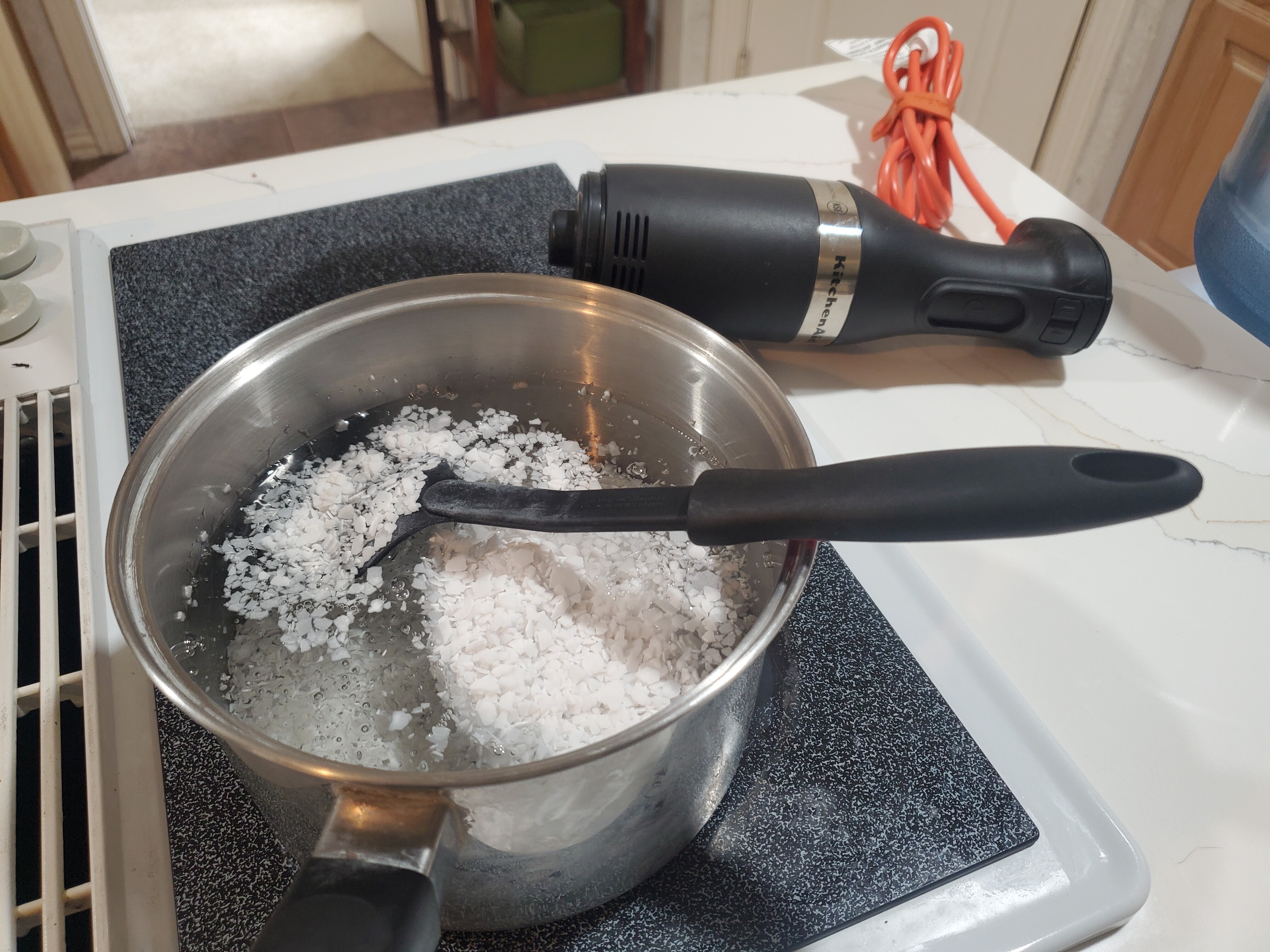
time to do the hard part
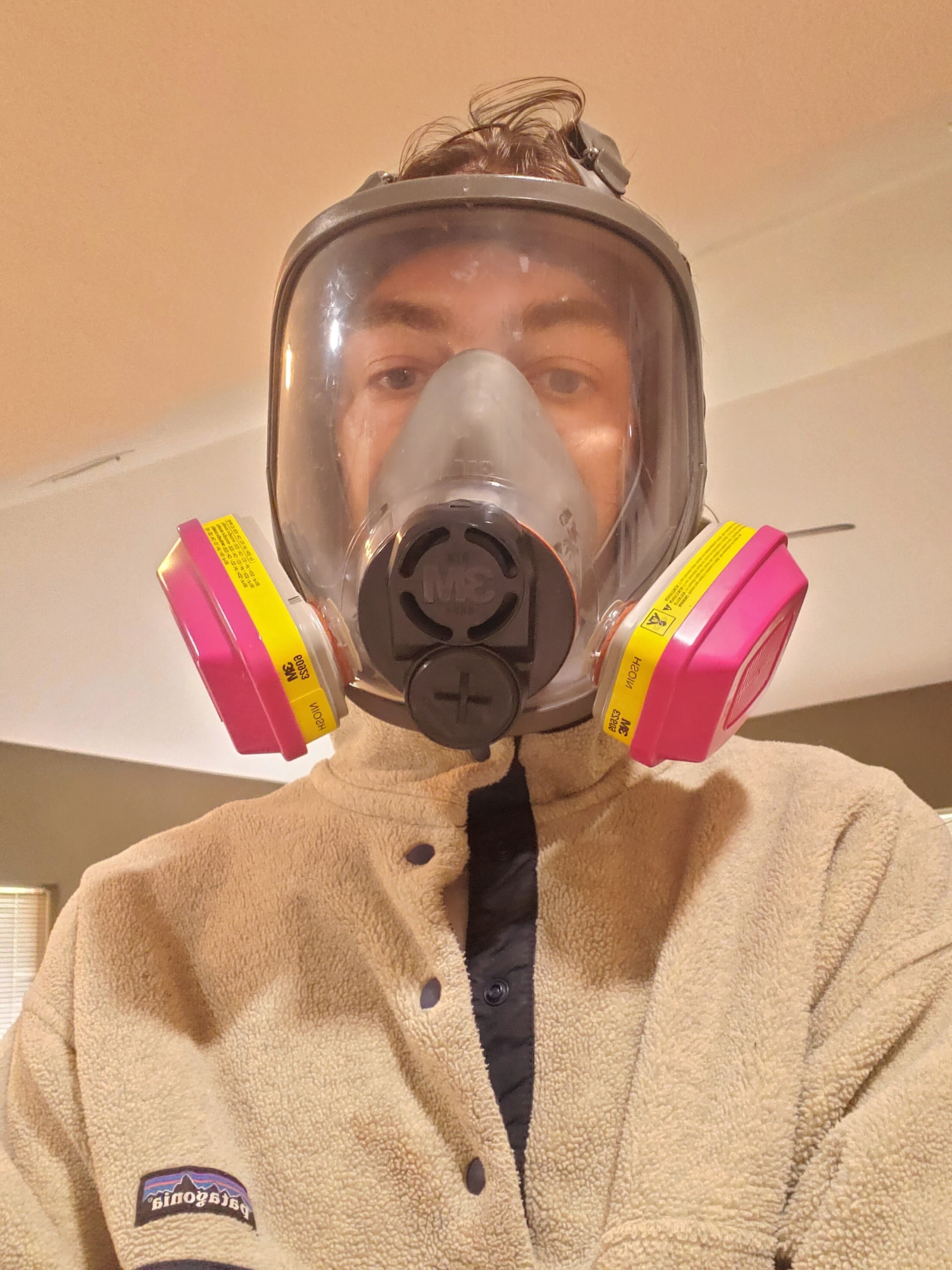
lye solution post-blend
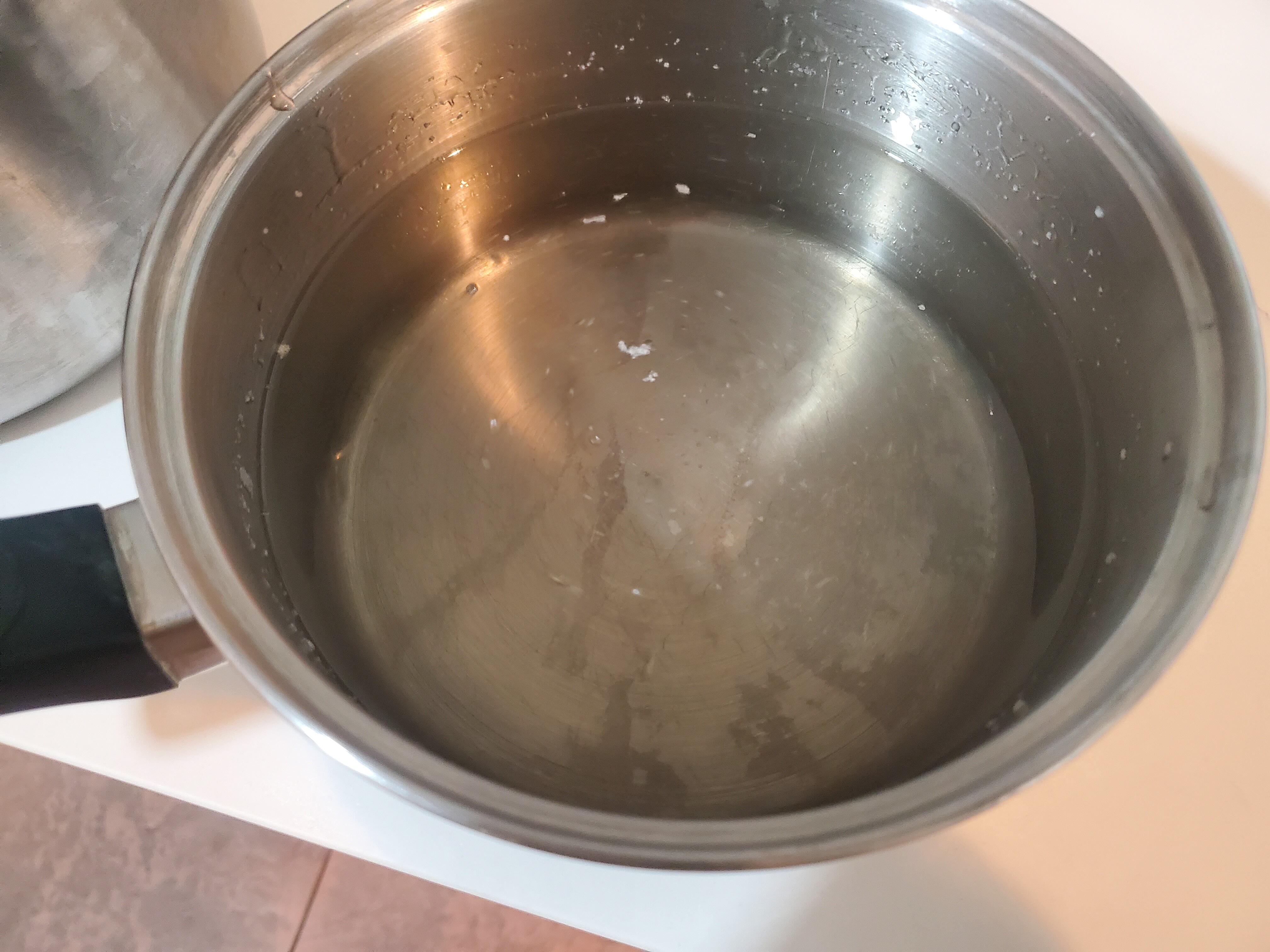
Just my 2nd batch using new commercial stick blender w/ power measured in hp rather than watts, which is very helpful for making ls when it's freezin' cold outside. I dunno why but I almost always end up making soap mostly in the winter
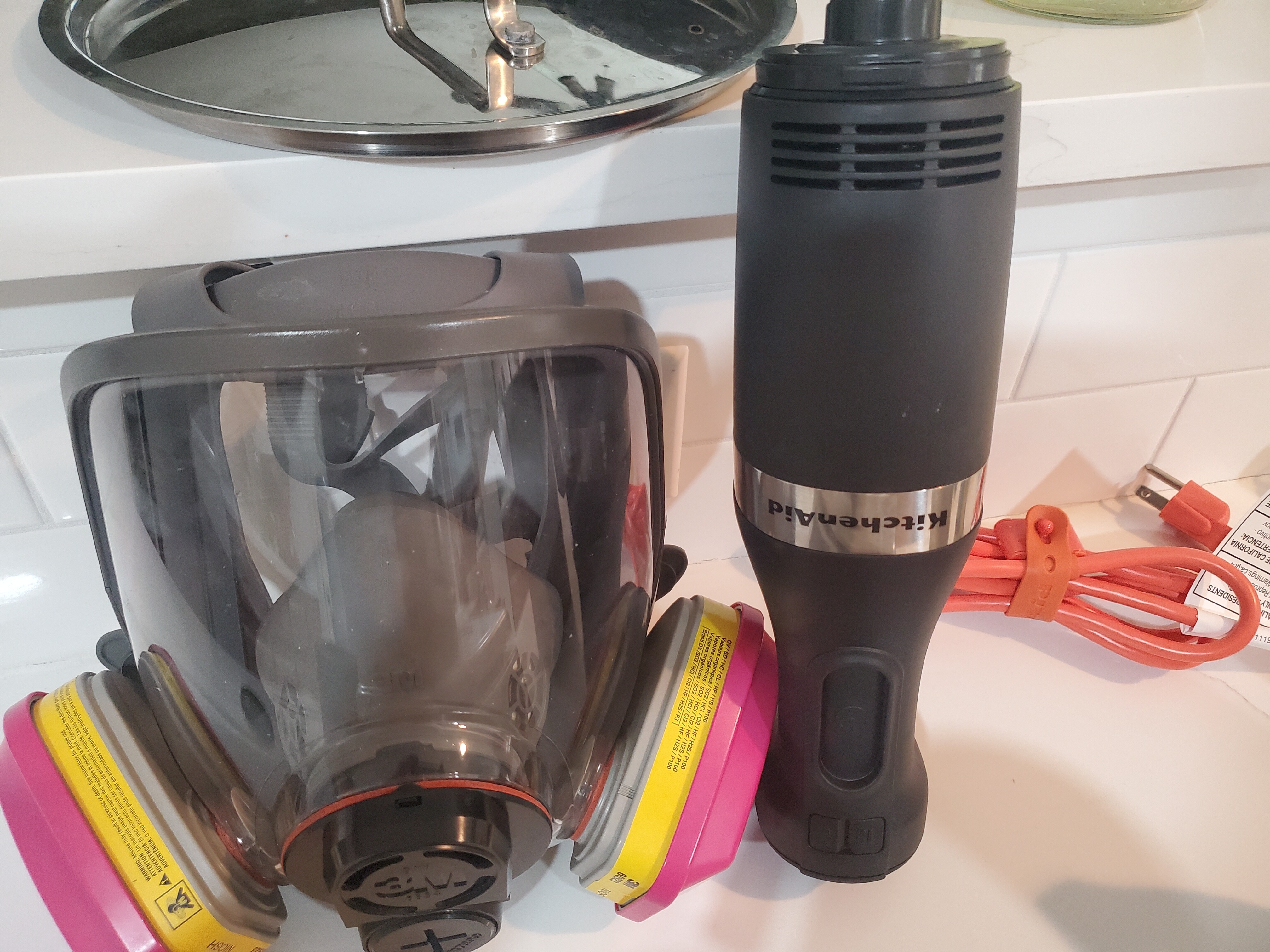
I think that's a wrap.
Just wrapped the pot up in a towel so now the universe will do the real work n i'll just pop back in tomorrow when it's finished turning into soap, take some more pics, dilute some of my new pt paste into ls, etc etc

you think the 10% pt is okay tho or what percentage pt would you recommend for ls?
When I saw the sodium hydroxide in the ingredients list I assumed that would be reacted with one of the oils. Do people really put un-saponified lye into body wash as some kind of cleaning agent? That's nutz
here's what it looks like initially right after mixing the lye w the fats and stickblending until i got some solids

i started off by melting the tar in a water bath for better pourability and easier measuring

then i measured & poured 10oz pine tar into smaller melting bowl to keep it soft while i melt the coconut, & measure the olive, lye, & glycerin

putting 20oz coconut in the main pot to melt

measuring the lye

actually i measured the glycerin first and accidentally used the lye value of 18.4 when it was supposed to be 61 so when I realized what i did i subtracted 18.4 from 61 and added that much more glycerin to make it right

the lye mixed into glycerin pre-blend

time to do the hard part

lye solution post-blend

Just my 2nd batch using new commercial stick blender w/ power measured in hp rather than watts, which is very helpful for making ls when it's freezin' cold outside. I dunno why but I almost always end up making soap mostly in the winter

I think that's a wrap.
Just wrapped the pot up in a towel so now the universe will do the real work n i'll just pop back in tomorrow when it's finished turning into soap, take some more pics, dilute some of my new pt paste into ls, etc etc
dangit i already made the soap, Ali@johnnyusa His label says that the 6.5% pine tar is based on the finished (diluted) soap - not the mix of oils that he used to make the paste. If that is correct and not a typo, and if we assume he diluted his paste at 50%, then there would be 13% pine tar in the paste recipe. If he diluted at 75%, then he'd have 19.5% pine tar.
Even so, I would agree it is misleading to list pine tar first, since typically the ingredient list would start with the ingredient of highest percentage, and go in order down to the lowest.
The second recipe isn't a true "soap" at all. With all the syndets and no saponifiable oils in there, the sodium hydroxide would be used as a pH modifier only. Funny how folks will gladly use a body wash like that, which actually contains sodium hydroxide, but be worried about using bar soaps (where all the NaOH is gone after production).
you think the 10% pt is okay tho or what percentage pt would you recommend for ls?
When I saw the sodium hydroxide in the ingredients list I assumed that would be reacted with one of the oils. Do people really put un-saponified lye into body wash as some kind of cleaning agent? That's nutz
Last edited:
Nah, sodium hydroxide is used as a pH adjuster in a fair number of cosmetic products, and is also used for making foods like olives, bagels, and something else I can't remember right now.dangit i already made the soap, Ali
you think the 10% pt is okay tho or what percentage pt would you recommend for ls?
When I saw the sodium hydroxide in the ingredients list I assumed that would be reacted with one of the oils. Do people really put un-saponified lye into body wash as some kind of cleaning agent? That's nutz
I'm sure your LS is fine with 10% PT - main thing is, do you like it?
Uh, hello?! Norwegian here reporting in from Minnesoh-ta headed into the long winter. Ever heard of lutefisk yah sure now?!Nah, sodium hydroxide is used as a pH adjuster in a fair number of cosmetic products, and is also used for making foods like olives, bagels, and something else I can't remember right now.
I'm sure your LS is fine with 10% PT - main thing is, do you like it?

Uff-dah, how could I have forgotten the ever-popular lutefisk??
- Joined
- Dec 8, 2017
- Messages
- 136
- Reaction score
- 148
i dunno if I like it yet, I think i brewed up a vat of petroleum hereNah, sodium hydroxide is used as a pH adjuster in a fair number of cosmetic products, and is also used for making foods like olives, bagels, and something else I can't remember right now.
I'm sure your LS is fine with 10% PT - main thing is, do you like it?
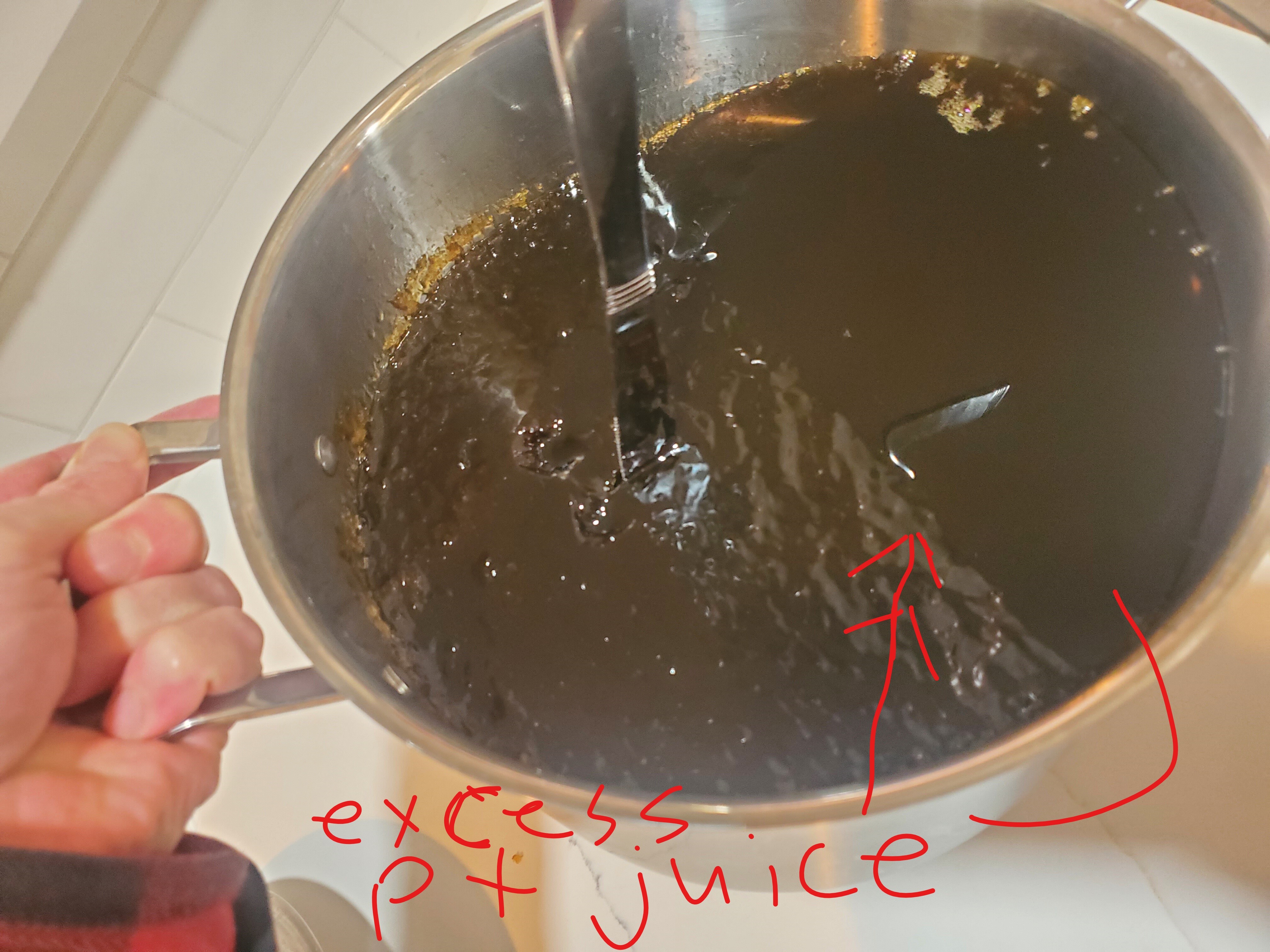
i think it's going to be good, but I've never had a batch of ls have a head of cream like this before.
My ls batches have always been completely solid the next morning, until this pt batch.
The 100% coconut ls i made last week also had some cream on top, but that cream was a semi-solid easily massed into a sphere for storage, whereas this pt cream is actually a liquid.
Suspect this cream has a very high concentration of whatever chemicals and turpentine were in the pt, plus whatever new mystery substances resulted from acid-base neutralization reaction between lye and pt
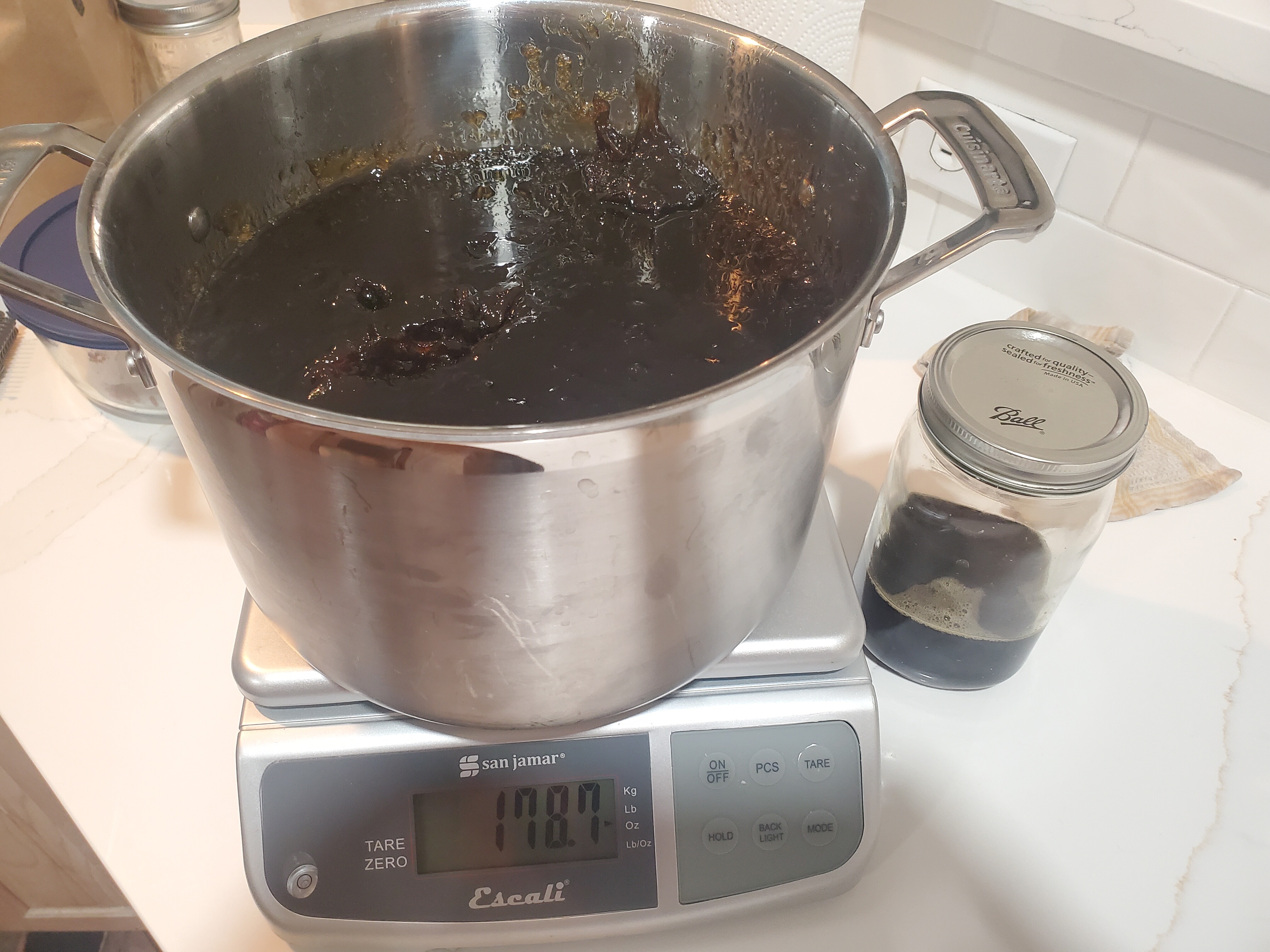
my total batch yield was 190 oz; 11.2oz liquid and 178.8 oz paste (i tared out scale w/ an identical pot)
paste after pouring off liquid
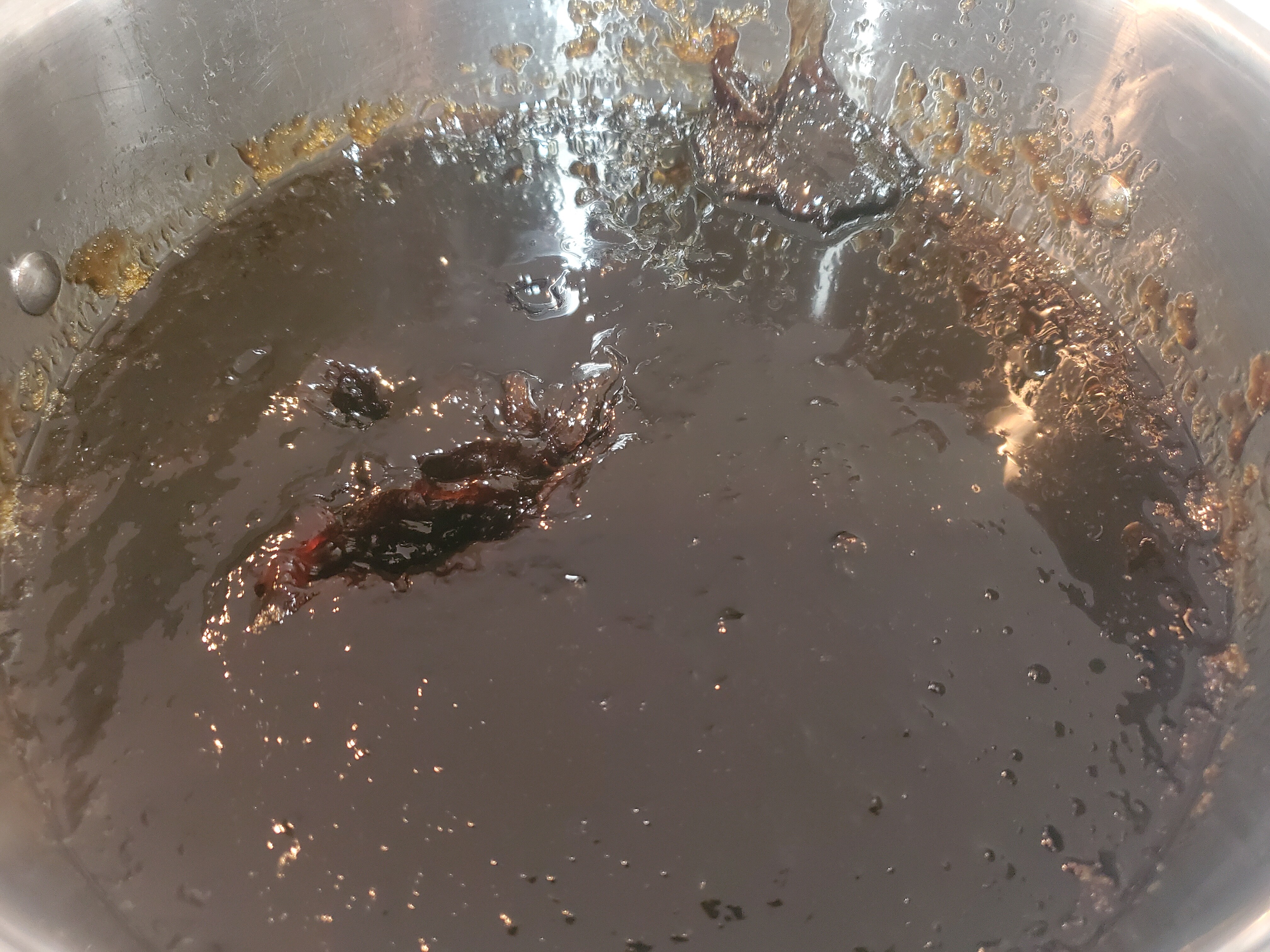
It's brown like coffee, or chocolate milk! Pine scent smells great. I think I'm going to like it.
scented it at over 0.5oz ppo w mostly peppermint and a little cedarwood and tea tree
this much diluted ls took 15.11% of the paste from my total batch that requires 1.56oz EOs @ 0.25oz ppo-- 15.1% of 1.56oz is 0.2356oz, or 6.679g, but i accidentally ended up spilling 15g of EOs in there for a slightly greater than 0.5oz ppo EO concentration that was 8.5 parts 1st distill peppermint, 3.5g cedarwood, 3g tea tree.
Dilution rate was perhaps a bit much, we'll see after sequestration
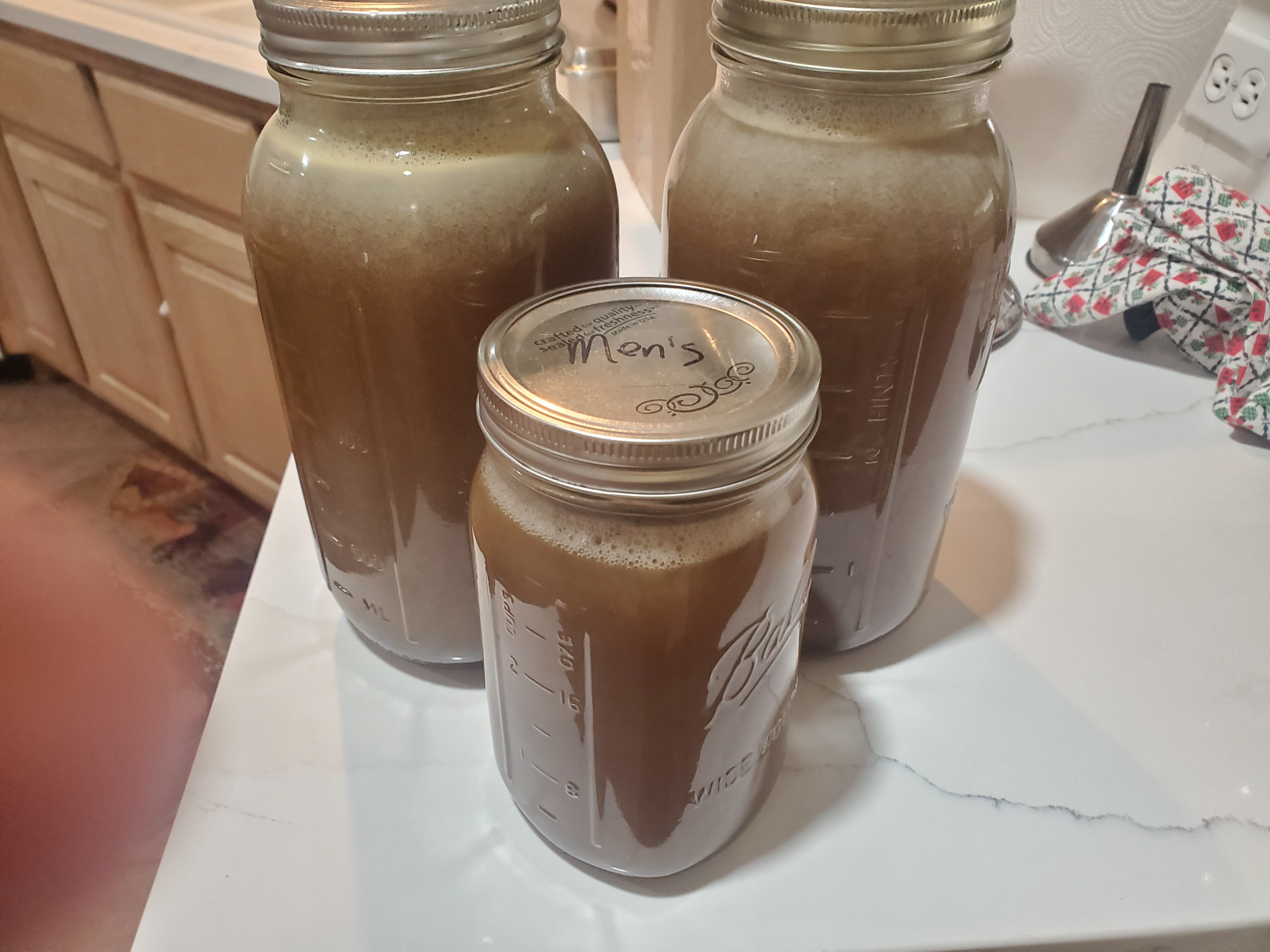
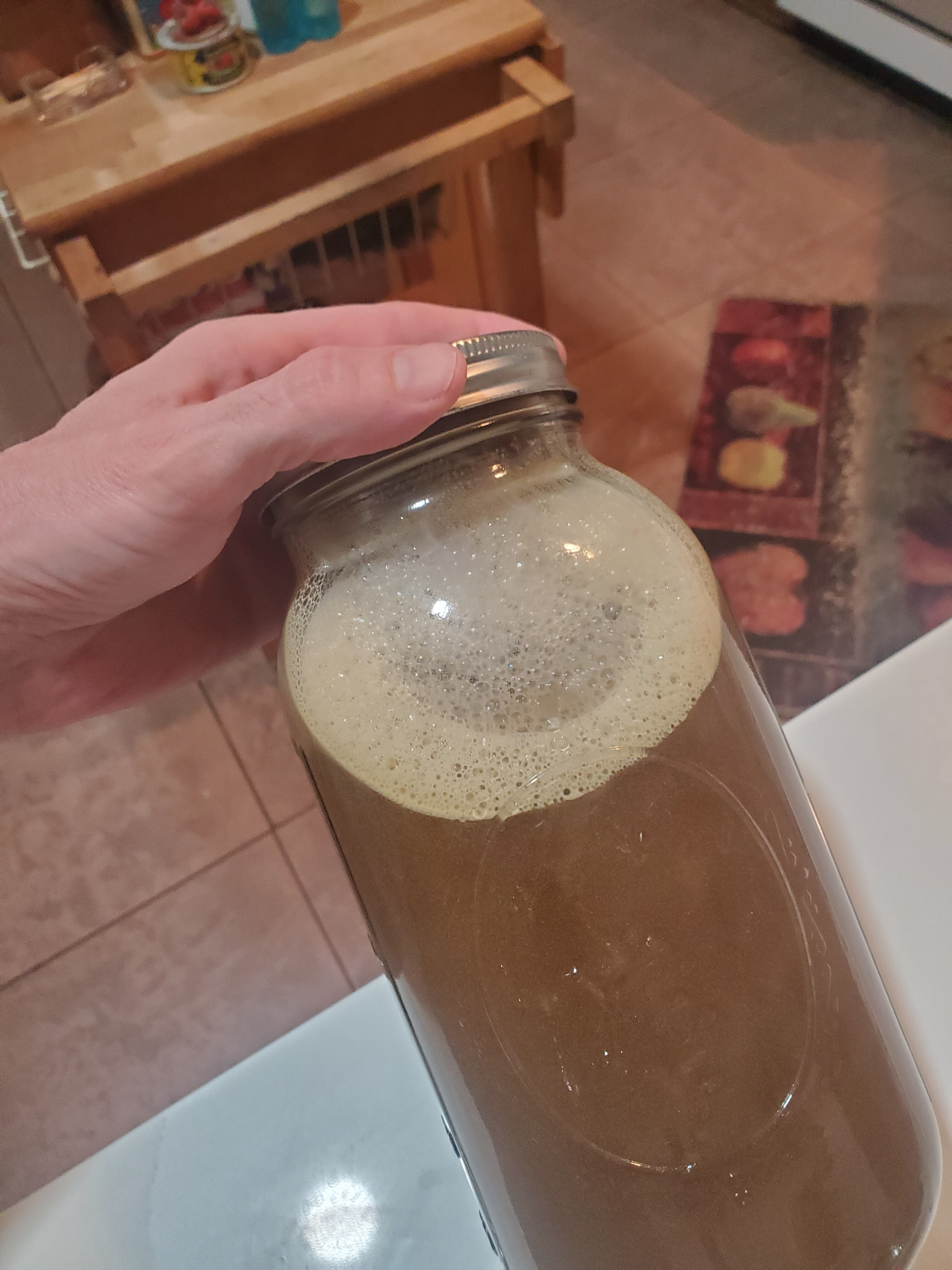
it's beautiful!!!
Last edited:
- Joined
- Dec 8, 2017
- Messages
- 136
- Reaction score
- 148
Let this one dry out for 12 days before unmolding & cutting bc next time I'll use less water content but came out nice, i think
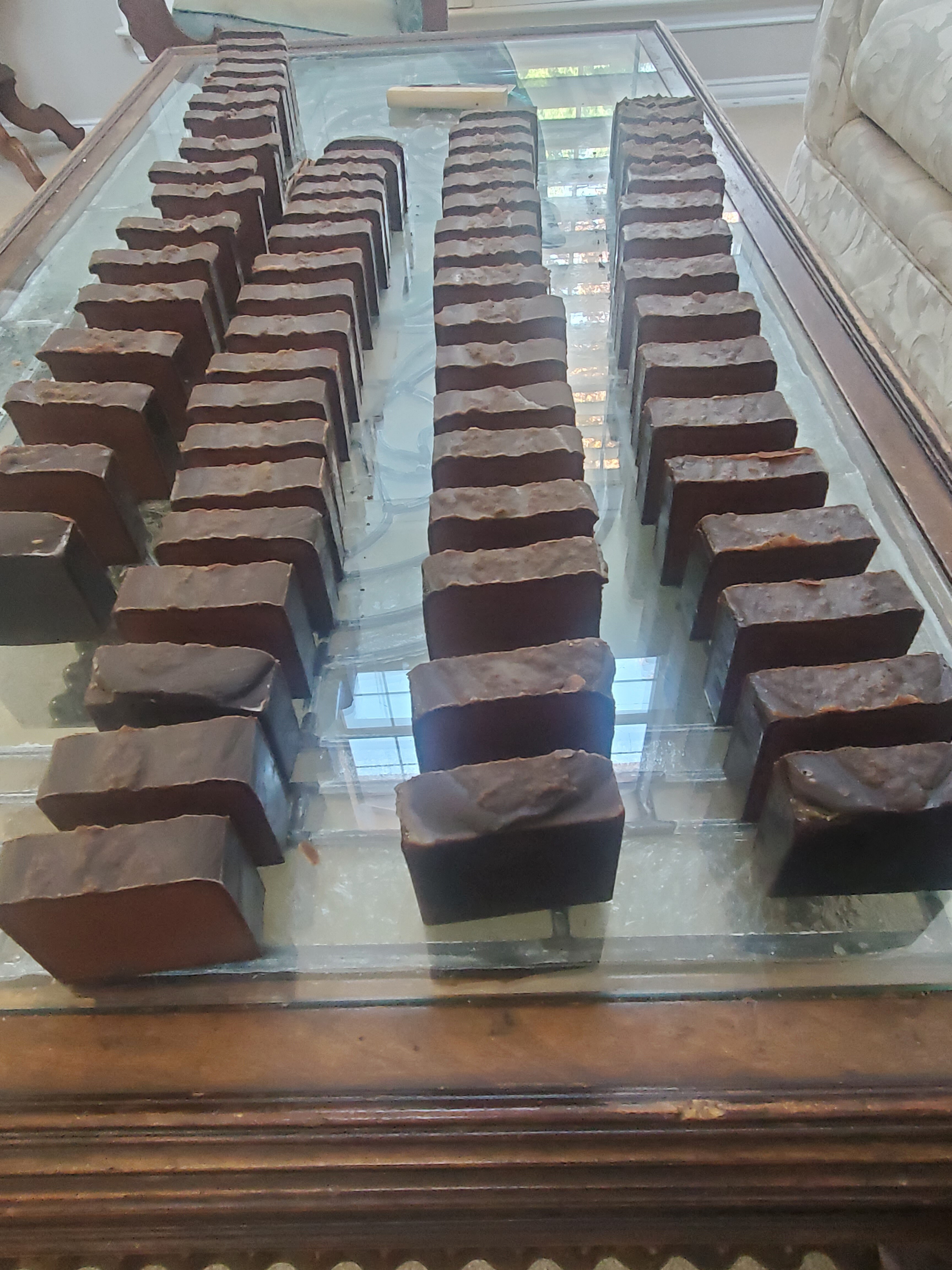
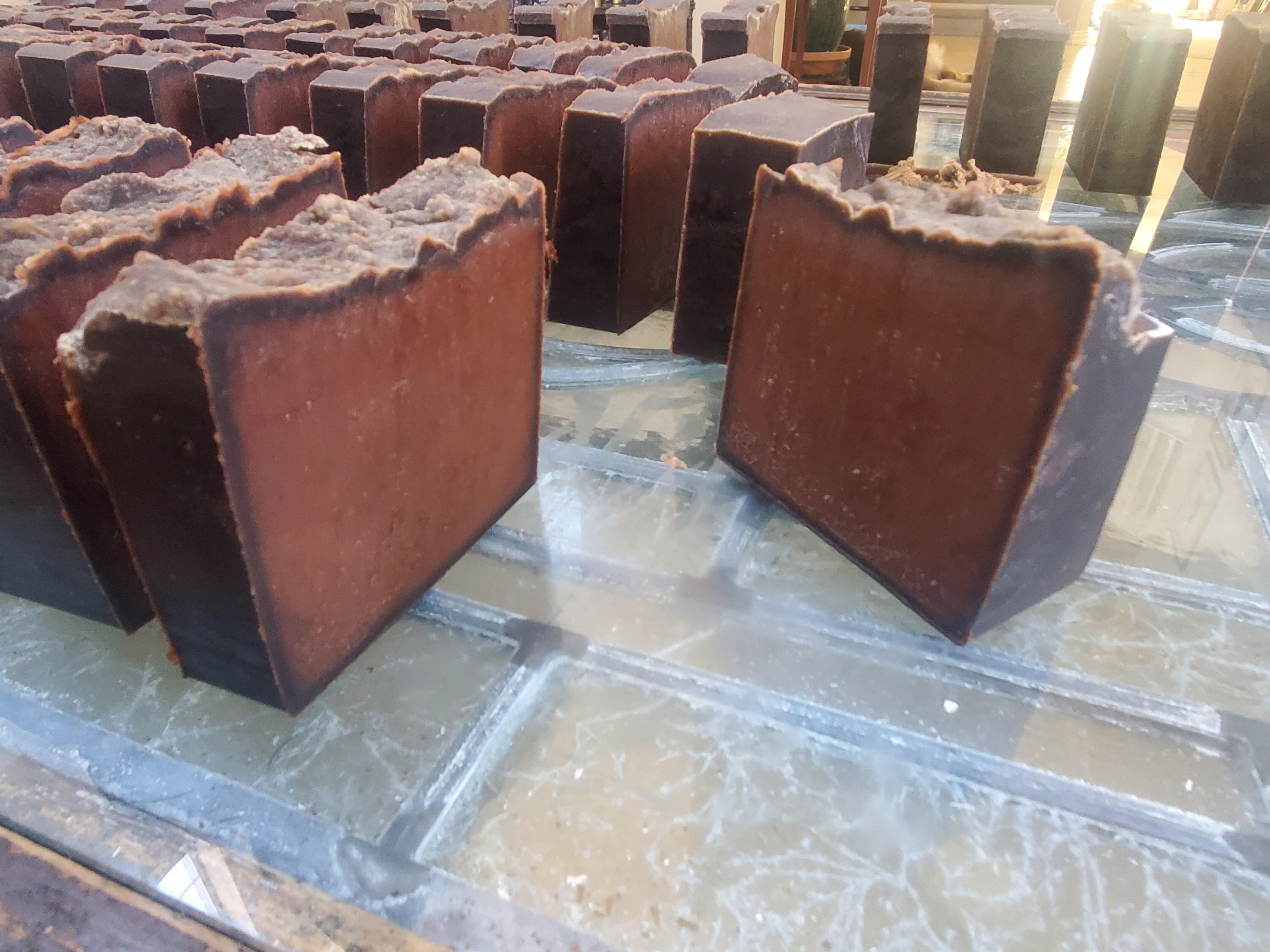


Hey there, recently held up from making soap due to this exact conflict. So, I ran some recipes in soap calc. One with pine tar at 8% of the recipe (listed as an oil), for the second one I plugged all the oils at the same amounts and excluded the pine tar which ended up reducing the batch by 8%. With the oils equal in both recipes and water ratio and super fat the same, I found that the lye required was the same. So. From my research I am seeing no difference. Finally made that soap today and it worked beautifully. Can’t wait to unmold and to try it!I'm looking for my peeps who've made pine tar soap. The interwebs give me conflicting information that pine tar saponifies, does not, does too, etc. I'm gathering from this Forum that pine tar does NOT saponify. Say I want a recipe with 20% pine tar. Do I then calculate a recipe volume at 80% of my mold, and just plug in my normal oil mixture and lye solution? Thanks for your help.
PS. I ended up choosing as an additive at 10%. Made a 1 lb batch as a trial.
Hope this makes sense.
I'm confused... if the batch was reduced by 8% when you removed the pine tar, then how can the oils be equal in both recipes? If what you are saying is that you added more of another oil to make up the weight of the pine tar, then the amount of each individual oil is not equal in both recipes.Hey there, recently held up from making soap due to this exact conflict. So, I ran some recipes in soap calc. One with pine tar at 8% of the recipe (listed as an oil), for the second one I plugged all the oils at the same amounts and excluded the pine tar which ended up reducing the batch by 8%. With the oils equal in both recipes and water ratio and super fat the same, I found that the lye required was the same. So. From my research I am seeing no difference. Finally made that soap today and it worked beautifully. Can’t wait to unmold and to try it!
PS. I ended up choosing as an additive at 10%. Made a 1 lb batch as a trial.
Hope this makes sense.
Also, although pine tar does not saponify, it does neutralize a small amount of lye. Try putting it into the soap calculator at 100% (screenshot below), and you will see. If you don't account for that, your superfat is going to be higher than you planned.

Pine tar doesn't saponify to make actual soap, but does react with alkali to form other chemical compounds.
For this reason pine tar should be included in the calculations for NaOH just as if it is a saponifiable fat. There are other ingredients that also don't saponify but are included in the list of fats for most soap recipe c@lculators. So pine tar isn't alone in being treated this way.
The amount of NaOH consumed by pine tar at 8% in a total of 16 oz of fats is pretty small. Small enough it could be ignored in this particular recipe. But the amount is not zero.
If you make a larger batch, as I do, and use pine tar at 20% of the total fats, as I do, the NaOH consumed is not negligible. I'd be making a mistake to not include the pine tar in the calculations for the weight of NaOH in the batches I make.
So I always include pine tar and similar ingredients in the list of fats when I calculating the alkali weight, regardless of the batch size or the % of the ingredient in the batch. That reduces the chance of making a mistake regardless of what kind of batch I'm making. Another benefit is the ingredient shows up properly in the recipe printout so I can follow it easier while I make the batch.
For this reason pine tar should be included in the calculations for NaOH just as if it is a saponifiable fat. There are other ingredients that also don't saponify but are included in the list of fats for most soap recipe c@lculators. So pine tar isn't alone in being treated this way.
The amount of NaOH consumed by pine tar at 8% in a total of 16 oz of fats is pretty small. Small enough it could be ignored in this particular recipe. But the amount is not zero.
If you make a larger batch, as I do, and use pine tar at 20% of the total fats, as I do, the NaOH consumed is not negligible. I'd be making a mistake to not include the pine tar in the calculations for the weight of NaOH in the batches I make.
So I always include pine tar and similar ingredients in the list of fats when I calculating the alkali weight, regardless of the batch size or the % of the ingredient in the batch. That reduces the chance of making a mistake regardless of what kind of batch I'm making. Another benefit is the ingredient shows up properly in the recipe printout so I can follow it easier while I make the batch.
Similar threads
- Replies
- 16
- Views
- 3K
- Replies
- 0
- Views
- 777




































